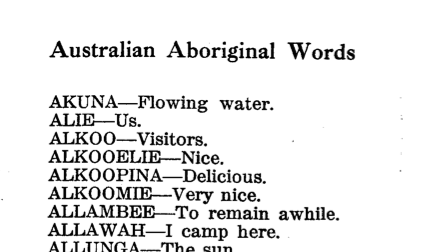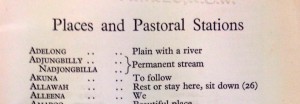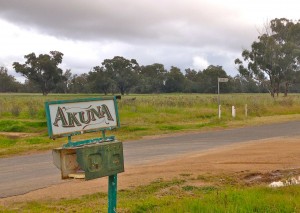Coining a new name from a word taken from an Australian language often has complex implications, even if the naming agency is oblivious to them. When the name is for a place, a suburb or a street or a park, the official approval involves the relevant local government body. Two writers went into some of the issues a few years ago:
- Tony Birch (2010 [1992]) sees the application of indigenous names to ‘houses, streets, suburbs and whole cities’ as ‘an exercise in cultural appropriation’. He draws a distinction between the restoration of indigenous placenames (such as Gariwerd ~ Grampians in western Victoria), and the fresh application to the built environment of a word imported from some Australian language.
- Sam Furphy (2002)
earlierdiscussed the role of what he dubbed ‘naming books’: popular twentieth century booklets of lists of ‘Aboriginal words’ such as Endacott (1923), Thorpe (1927), Kenyon (1930), Cooper (1952), which, for all the expressed good intentions of their compilers, have contributed to a homogenised perception of Australian languages: ‘The earliest popular naming books … make virtually no reference to the variety of languages spoken by the indigenous people of Australia, such that an uninformed reader could be forgiven for believing that there was only one Aboriginal language.’ (Furphy 2002:62) ‘Naming books simplify and romanticise Aboriginal words and remove them from their cultural and linguistic context.’ (Furphy 2002:68)
I’ve recently come upon an example which illustrates a combination of both concerns: one where official placenaming has drawn on the notorious naming booklets.This case study begins in 1865 with the posting of SA Police trooper Samuel Gason (c1842–97) at Lake Hope in Dieri country, where he made some of the earliest notes on the Dieri language. These were published first as Gason (1874), and then reprinted a few times notably by Curr (1886:75–107). Gason’s (1874) vocabulary included the entry Akuna ‘To flow (as water flowing or running)’. We can recognise this word as the Dieri (Diyari) intransitive verb ngaka-rna ‘flow (of water), blow (of wind)’ (Austin 2014:20). As Austin (2013:246) observed, Gason didn’t record word-initial velar nasal ŋ (ng in the modern orthography), he just omitted it; and he often wrote the letter u for the low vowel a (and wrote oo for the high back vowel u, as for example in his mundroola for mandru-lha, a word I recently guest blogged about).
Akuna was repeated (on page 88) in the Curr (1886:75–107) reprint of Gason’s work, and then in turn appeared as the very first entry, Akuna ‘Flowing water’, in Sydney John Endacott’s (1923:7) influential naming booklet:

Akuna kept the leading position in at least the first four editions (to 1944) of Endacott’s booklet, and was excerpted in a list of suggested house names published in a letter to an Adelaide newspaper (Anonymous 1937). By the 9th enlarged edition (Endacott 1955) Akuna had dropped to ninth position, still high on the first page of names — and just below an added entry Akoonah ‘Flowing water’. We can infer by the way that Endacott’s booklets provided the name for Akuna St in central Canberra (Civic and Reid), gazetted in 1956, because the stated origin “Aboriginal word meaning ‘flowing water’ ” matches the gloss. Similarly, a booklet offering ‘musical Aboriginal words’ (Anonymous 1980) must have copied Akoonah ‘Flowing water’ from Endacott.
The spelling Akoonah was introduced, it appears, by Kenyon (1930:9) who listed Akoonah ‘Water (running)’ (C[entral].A[ustralia].). The entry was repeated in the later editions Kenyon (1951:7) and Kenyon (1982:2) as Akoonah ‘Water running’ (C.A.). Cooper (1949:5) and Cooper (1952:5) had Akoonah ‘Running water’, which was excerpted in a list suggested house names published twice in the Australian Women’s Weekly (Anonymous 1961:29 and Anonymous 1966:35). Cooper (1969:6) shortened the word to Akoona. Ingamells (1955:13) had the entry Akoonah (L[ake].E[yre].) ‘Running water’. Cooper’s geographic designation and the word ‘running’ in the gloss hark back to Gason’s vocabulary, and implies that Cooper did not copy from Endacott, but probably from Curr (or another version of Gason). Rex Ingamells (1913–55) (of Jindyworobak fame) was from Adelaide and could well have copied from Cooper, but the more specific geographic designation suggests he was aware that Gason was the source. I have not found another possible language record behind Akoonah, and I take it to be a respelling of Akuna. Kenyon (thinking ‘words are spelt in the ordinary English way’ 1982:iii), or whoever introduced Akoonah, was presumably was trying to overcome the ambiguity of sound indicated by English u, but the wrong ‘correction’ was unwittingly chosen (Akana, say, would have been better). The appended Table’s columns show the publication lineages of the variants.
The reference to flowing or running water has clearly appealed to many agencies when they were selecting a name, because ‘Akuna’ or ‘Akoonah’ has been applied to over forty suburban streets, avenues, drives, closes, courts, and a rural lane; most of them are indicated on these two custom Google Maps. (You can click the ‘full screen’ button, top right of each map, to see details and change the view.)
Notice that just about all the geographic features bearing these names are in the built environment. Even one feature which from the name appears to be natural turns out to be partly artificial: the name Akuna Bay was applied around 1970 when a marina and associated development was planned for what had been the mouth of a tributary of Coal and Candle Creek in Ku-Ring-Gai Chase National Park. The name Akuna also has been, and is, borne by a ship, boats, houses, racehorses, and dozens of businesses and registered companies (often having to do with water).
In addition, the name has been applied privately to at least 17 homesteads across eastern Australia. (Those are just the larger properties which have been listed in Geoscience Australia’s gazetteer; there would be a number of smaller farms, ‘lifestyle blocks’ and holiday houses also with the name.) As an aside, note that the homestead names with the spelling Akoonah are in SA or adjacent parts of Victoria (and one in WA), whereas none of the Akuna homesteads are in SA, and seven of the nine are in NSW and Queensland. This fits with the SA connections of Cooper (he was employed at the SA Museum where his booklet was published), and Ingamells (who was from Adelaide). Just from the evidence of the two maps above, it would appear that the Endacott and Kenyon booklets were used predominantly in Victoria, NSW, and southeast Queensland.

And as if Dieri ngakarna ‘to flow’ couldn’t get more mangled, it looks like it morphed in another way. On the first page of the 4th edition of Australian Museum’s compilation of NSW ‘Places and Pastoral Stations’ (McCarthy 1952:5), the third entry was Akuna ‘To follow’. (There was no corresponding entry in the earlier editions, Thorpe 1927,1938.) This meaning has been repeated in the entry for Akuna Bay in a popular reference book on Sydney suburb names, Anderson (1989:9): “Said to be from an Aboriginal word meaning ‘to follow’”, which was then cited in the official NSW Register of geographic names, and this in turn is cited in the Wikipedia entry. My best guess is that McCarthy’s addition (likely from Endacott, though possibly Curr or Gason) involved a misreading of ‘flow’ as ‘follow’ (I have not otherwise found a match for it). Also, when Akuna Bay was named (around 1970) the bestowers would have had in mind the ‘flowing water’ meaning rather than ‘to follow’.
Throughout the 20th century a better record of the word was buried in Reuther’s monumental c1901 dictionary: ngakana (v) = ‘to flow downstream,’ etc. (<III,174> 2069), with examples involving water, blood, mucus, tears, perspiration, fat, resin, drizzle, wind, and cold air. But Reuther’s work was effectively unavailable to the popular compilers, as it was not translated (from German) until Reuther and Scherer (1973:1467), or published until Reuther (1981 [1901]) (and then only in a limited way on microfiche). On a comparative note, closely related words in other languages of the same subgroup were also recorded by Reuther: Ngamini ngakana ‘to flow, to run over’, and Yawarrawarrka (Yawarrawarga) ngakindri ‘to flow’; and ngaka is a word for ‘water’ in a couple of languages of southwest Queensland (Pirriya and Wangkumarra). In Paakantyi (Darling River), ngaka means ‘tears’ (Thieberger and McGregor 1994:45).
In short, in modern Australian usage as a ‘euphonious’ name Akuna or Akoonah, the word ngakarna has been anonymised from its linguistic and geographic origins. It has further been dislocated from its part of speech and authentic pronunciation (beyond the demands of English loan phonology). All that remains is some connection to flowing water (and even that has been lost where it has been glossed as ‘to follow’), and this now esoteric attribute is appreciated now only by the few who have informed themselves of it.
Appendix: Lineages of publication
|
decade |
|
ngakana (v) |
||||
|
1860s |
Samuel Gason
(c1842–97) at Lake Hope |
|||||
|
1870s |
Gason 1874 Akuna ‘To
flow (as water flowing or running)’ |
|||||
|
1880s |
Curr 1886:75–107
|
|||||
|
1890s |
||||||
|
1900s |
JG Reuther’s Diari dictionary |
|||||
|
1910s |
||||||
|
1920s |
Endacott 1923:7 Akuna |
(not in Thorpe 1927) |
||||
|
1930s |
Endacott 1930s |
Akoonah Kenyon 1930:9 |
(not in Thorpe 1938) |
|||
|
1940s |
Endacott 1944 |
Akoonah ‘Running water’ Cooper 1949:5
|
||||
|
1950s |
Endacott 1955 Akuna & |
Kenyon 1951:7 ‘Water running’ |
Cooper 1952:5 |
Ingamells 1955:13 |
McCarthy 1952:5 Akuna ‘to |
|
|
1960s |
Anonymous 1961:29 Cooper 1969:6 Akoona |
|||||
|
1970s |
Endacott 1973 Akuna & |
Reuther and |
||||
|
1980s |
Anonymous 1980 |
Kenyon 1982:2 ‘Water running’ |
Anderson 1989:9 |
Reuther 1981 [1901] |
||
|
1990s |
||||||
|
2000s |
||||||
Table: Lineages of ngaka-rna ‘flow (of water), blow (of wind)’; columns show descent of variants from one publication to another
Acknowledgement
I have made appreciative use of the February 2013 version of the Pama-Nyungan etymological database funded by NSF grant 0844550 ‘Pama-Nyungan and Australian Prehistory’ awarded to Claire Bowern. [added 16 July 2014]
References
Anderson, Ken. 1989. Sydney’s suburbs : how and why they were named. Kenthurst [N.S.W.]: Kangaroo Press. http://trove.nla.gov.au/version/22731580
Anonymous. 1937. Aboriginal house names. Chronicle (Adelaide) 1 April 1937, p.55. http://nla.gov.au/nla.news-article92486622
Anonymous. 1961. Aboriginal house names and their meanings. Australian Women’s Weekly 20 December 1961, pp.2,28–29. http://nla.gov.au/nla.news-page4830882
Anonymous. 1966. Aboriginal house names and their meanings. Australian Women’s Weekly 27 April 1966, pp.32–33,35. http://nla.gov.au/nla.news-page4939793
Anonymous. 1980. Musical Aboriginal words : address book. [Melbourne]: Dynamo House. http://trove.nla.gov.au/version/34803420
Austin, Peter K. 2013. A grammar of Diyari, South Australia. https://www.academia.edu/attachments/32282840/download_file
Austin, Peter K. 2014. A dictionary of Diyari, South Australia. https://www.academia.edu/attachments/30509250/download_file
Birch, Tony. 2010 [1992]. ‘Nothing has changed’: The making and unmaking of Koori culture. Meanjin 51.2:229–246. Reprinted 2010, Meanjin 69.4:107–118. http://search.informit.com.au/documentSummary;res=IELAPA;dn=502606748332707
Also reprinted 1997 pp.11–28 in Race matters: Indigenous Australians and “our” society, ed. by Gillian Cowlishaw and Barry Morris. Canberra: Aboriginal Studies Press. http://books.google.com.au/books?id=xYSGAwAAQBAJ&pg=PA11; and 2003 pp.145–158,208–211,214–231 in Blacklines: Contemporary critical writing by Indigenous Australians, ed. by Michele Grossman. Melbourne University Press. [amended 17 July 2014]
Cooper, H. M. 1949. Australian Aboriginal words and their meanings. Adelaide: South Australian Museum. http://trove.nla.gov.au/version/31576216
Cooper, H. M. 1952. Australian Aboriginal words and their meanings. [Adelaide]: South Australian Museum, 2nd ed. rev. and enlarged edition. http://trove.nla.gov.au/version/22390169
Cooper, H. M. 1969. Australian Aboriginal words and their meanings. Adelaide: South Australian Museum, 4th edition. http://trove.nla.gov.au/version/24073699
Curr, Edward M. 1886. The Australian race: its origin, languages, customs, place of landing in australia, and the routes by which it spread itself over that continent, volume 1. Melbourne: John Ferres, Government Printer. http://www.archive.org/stream/australianracei01currgoog
Endacott, Sydney J. 1923. Australian Aboriginal native names and their meanings. Melbourne: Sydney J. Endacott, 1st edition. http://nla.gov.au/nla.aus-vn938496
Endacott, Sydney J. 1955. Australian Aboriginal words and place names and their meanings. Melbourne: Georgian House, 9th enlarged edition. Reprinted with additions 1963.
Endacott, Sydney John. 1973. Australian Aboriginal words and place names and their meanings. Melbourne: Acacia Press, 10th edition.
Furphy, Sam. 2002. Aboriginal house names and settler Australian identity. Journal of Australian Studies 26:59–68. http://www.api-network.com/main/pdf/scholars/jas72_furphy.pdf
Gason, Samuel. 1874. The Dieyerie tribe of Australian Aborigines. Adelaide: W.C. Cox, Government Printer. http://trove.nla.gov.au/version/20919468
Ingamells, Rex. 1955. Australian Aboriginal words: Aboriginal–English; English–Aboriginal. Melbourne: Hallcraft Publishing Company.
Kenyon, Justine. 1930. The Aboriginal word book. Melbourne: Lothian Publishing Company.
Kenyon, Justine. 1951. The Aboriginal word book. Melbourne: Lothian Publishing Company, 2nd ed. completely revised. edition.
Kenyon, Justine. 1982. The Aboriginal word book. Melbourne, Sydney: Lothian Publishing Company.
McCarthy, Frederick D. 1952. New South Wales Aboriginal place names and euphonious words, with their meanings. Sydney: A. H. Pettifer, Govt. Printer.
Reuther, Johann Georg, and Philipp A Scherer. 1973. The Diari / translated by P.A. Scherer. http://www.aiatsis.gov.au/collections/docs/findingaids/MS2289.PDF, typescript.
Reuther, Johann Georg. 1981 [1901]. The Diari. Translated (as A Diari Dictionary) by the Rev. P.A. Scherer. AIAS Microfiche No. 2. Canberra: Australian Institute of Aboriginal Studies.
Thieberger, Nick, and William McGregor, eds. 1994. Macquarie Aboriginal words: a dictionary of words from Australian Aboriginal and Torres Strait Islander languages. North Ryde: Macquarie Library.
Thorpe, W. W. 1927. List of New South Wales Aboriginal place names and their meanings. Sydney: Australian Museum, 2nd edition. http://nla.gov.au/nla.aus-vn1890695
Thorpe, W. W. 1938. List of New South Wales Aboriginal place names and their meanings. Sydney: Australian Museum, 3rd edition. http://nla.gov.au/nla.aus-vn3721657

 Follow
Follow
Nice!
A very nice piece of work David. As usual, it is meticulously researched and logically argued. I agree with your theory of the transposition of the and in ‘flow’ to ‘follow’. It is a common phenomenon in typed written texts. The literature abounds in examples of words and toponyms that owe their current form to an error of perception or an orthographic misrepresentation. Well done!
Jan
An abridged version has now been published in the December ANPS newsletter Placenames Australia http://www.anps.org.au/documents/Dec_2014.pdf.
Another booklet is Sugden’s, in the Endacott lineage: the first page has ‘Akuna Flowing water’.
Sugden, Joah H. [1954]. Aboriginal words and their meanings. Sydney: Dymock’s. http://trove.nla.gov.au/version/16699786
Further on Akuna St in central Canberra: although gazetted in 1956, the name was in the first (1927) ‘Report in regard to the naming of Canberra’s streets and suburbs’ from a Parliamentary committee, and there glossed ‘Flowing water’ (p.7). Akuna was one of 23 in this subset: “Names representative of all the principal Australian dialects have been chosen and they were also selected in alphabetical order, radiating outwards from London Circuit.”